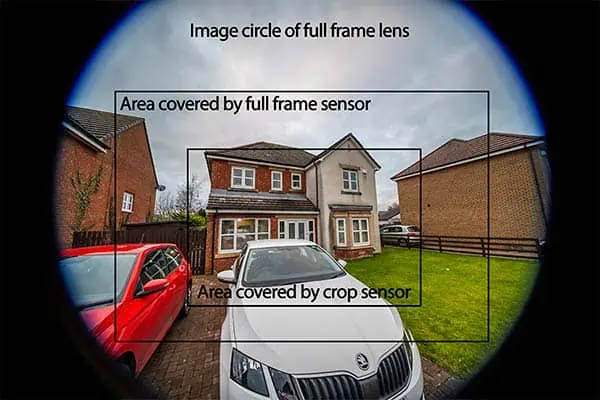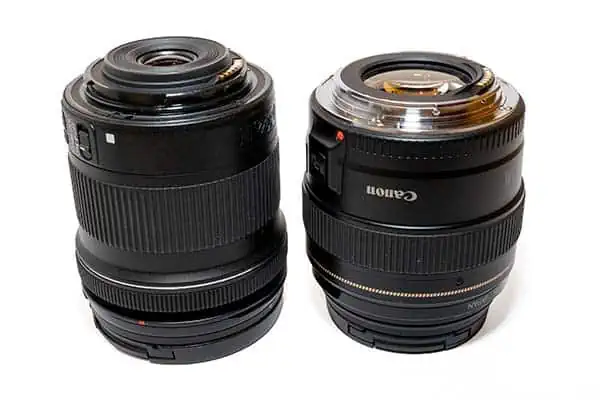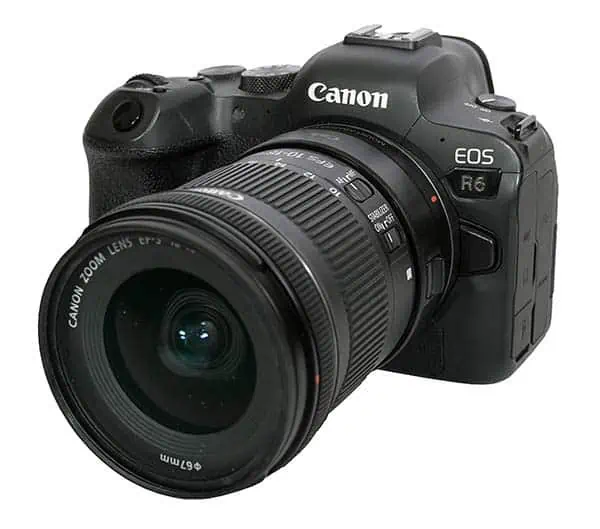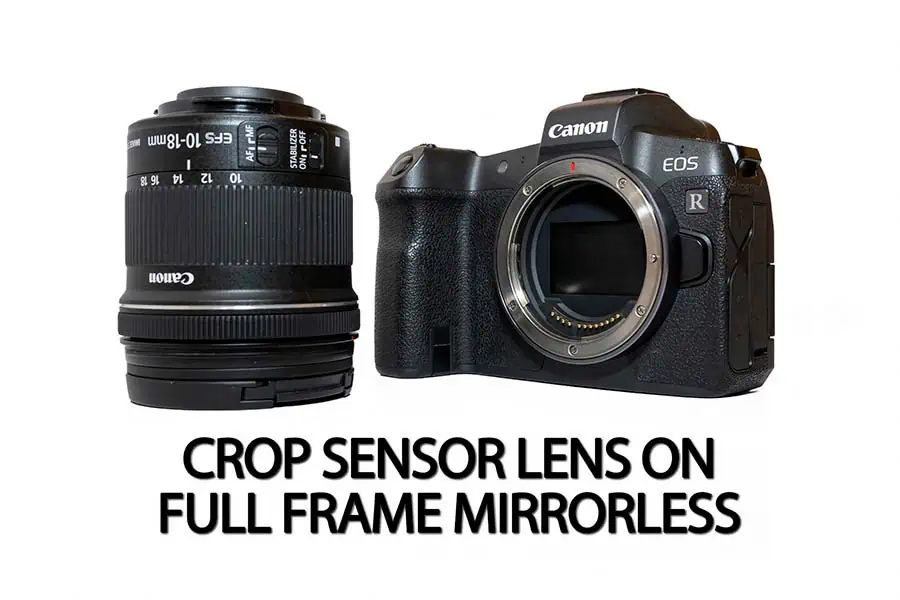DIY Video Studio is supported by its readers who use the affiliate links or ads on this site. As an Amazon Associate, I earn from qualifying purchases. Thank your support if you use any of the links.
Author: Tosh Lubek Published: 5 February 2023
Generally, crop sensor lenses do not work with full-frame DSLR. But Canon EF-S lenses can be adapted onto EOS R series full-frame mirrorless cameras. When you mount an EF-S lens the camera automatically switches to crop mode to match the lens image circle. It works for stills and is even better for video.
If you’re transitioning from a Canon crop sensor DSLR to a Canon full-frame mirrorless camera, you should consider keeping your crop sensor lenses. This is especially true if you’re a vlogger or social media content creator and you’re working on a small budget.
But how do you know if continuing to use crop sensor lenses is right for you?
In this guide, I’ll explain how to use crop sensor EF-S lenses on Canon’s popular full frame RF mount cameras and explore the advantages, limitations, and give a little background to make this easier to understand. Hopefully, all of that will all you to make an informed decision on using EF-S crop sensor lenses on a Canon EOS R series camera.
What is a crop sensor lens?
A crop sensor lens is designed for crop sensor cameras (APSC). These cameras have smaller image sensors than full-frame cameras, so crop sensor lenses can produce smaller image circles and still cover the whole sensor. So, the lens design can be smaller, lighter, and cheaper than for full-frame lenses.
If you look at the next image, you can see the image circle created by a full-frame lens. That’s right, the lens produces a circular image. It’s easy to forget that the image should be that shape because we’re used to images being squares or rectangles. Images are rectangles and not circles because that’s the shape of the sensor.

However, take another look at the image and you’ll see I’ve shown the outlines of what would be a full-frame sensor and a crop frame sensor. If you put a full frame lens onto a crop sensor camera, you’re wasting all the image outside the area covered by the sensor. It makes more sense to design a lens that produces a smaller image circle that’s just outside the perimeter of the crop sensor. That will mean you can make a smaller, lighter, and cheaper lens. That’s exactly what a crop sensor lens is.
Why can’t I use a crop sensor lens on a full-frame DSLR camera?
In this article, I’m specifically talking about Canon cameras, and it is the case that you cannot mount a Canon EF-S crop sensor lens onto a Canon full-frame DSLR body. This isn’t because the mount flanges on Canon full-frame and crop sensor DSLRs are different, because basically, they are the same. What is different is that Canon’s EF-S lenses include a plastic “bumper” to protect the rear lens element that can protrude beyond the flange.
I can demonstrate by showing you an EF-S 10-18mm lens and an EF 85mm side by side. Notice the extra height of the plastic bumper at the rear of the crop sensor lens. I have seen videos on YouTube where this plastic bumper has been removed, either by just pulling it away or by cutting it with a hacksaw.

I have seen videos on YouTube where this plastic bumper has been removed, either by just pulling it away or by cutting it with a hacksaw. I would not recommend either method. Although this would allow the lens to fit an EF mount you would run the risk of the rear lens element hitting the flip-up mirror in a full-frame DSLR, making it a potentially costly mod.
Although this extra bumper on Canon EF-S lenses is a problem, apparently some third-party EF-S lenses do not have the rear element poking out beyond the mount. An example is the Sigma 18-35mm f1.8.
Why use a crop sensor lens on a full-frame mirrorless camera?
The first advantage is if you’re upgrading from a Canon crop sensor DSLR to one of their full-frame mirrorless cameras. You can keep your EF-S lenses, gradually replacing them when you can afford them (Canon RF L lenses are very expensive).
Even though EF-S lenses are generally very affordable (cheap); the image quality can be impressive. And when paired with a Canon full-frame mirrorless camera, the autofocus works very well.
Many of the EF-S lenses feature image stabilization (IS), making it easier to get sharp shots in low light conditions and smooth handheld video.
It’s worth noting that with an EF-S lens on an R series mirrorless camera, you won’t be able to access high frames rates, you on most you will be able to shoot 4K at up to 60fps, although the original EOS R can only manage 4K at 30fps. However, on the plus side, for EOS-R owners, if you use EF-S lenses you won’t experience the same 1.74x crop in 4K that you would with full-frame lenses.
These lenses are also perfect for travel and backpacking, as they’re lightweight and easy to carry around. And if you want to experiment with different focal lengths without breaking the bank, try the EF-S version first. Buying a Canon RF “L” lens and only then discovering you don’t need that focal length will leave a big hole in your pocket.
If you’re a vlogger using an R series mirrorless camera you can get the RF16mm f2.8 lens, which is a non-L lens (i.e., it’s cheap). However, the EF-S 10-18mm lens might be the better choice. Although both lenses cost about the same (about $300) you can get used EF-S 10-18mm lenses for less than half that. The EF-S 10-18mm also has image stabilization, which the RF16mm does not have, and I think the EF-S 10-18mm is sharper in the corners. If the slower aperture is a concern, you can get an on-camera LED light for about $30.
What are the disadvantages of using EF-S lenses on EOS R series cameras?
I’ll admit using EF-S lenses on your Canon full-frame mirrorless camera isn’t always going to be perfect. For instance, they don’t have any weather sealing and they’re not fast lenses. The fastest is f2.8, which includes the 24mm pancake, 17-55mm, and 60mm Macro.
If you’re into slow motion you’ll be disappointed, although you can shoot 4K at up to 60fps, except on the EOS R and RP.
If you’re a photographer who likes large prints, this route may not be for you. Because your full-frame mirrorless camera will crop in on the image, you will lose a lot of pixels, in fact, you’ll only be using about 38% of the sensor. So, an EOS-R goes from 30MP to 11.4MP, an R6 goes from 20MP to 7.6MP, and R5 goes from 45MP to 17.1MP.
If you want the simple formula to calculate the megapixel count on your camera after switching to crop mode check out my article How Many Megapixels When I Change Full Frame to Crop Mode.
Finally, unless you have a good reason for using EF-S glass on a Canon full-frame camera it might seem crazy to use cheap lenses on an expensive camera body. You won’t be realizing the full potential of your camera.
How to use an EF-S lens on EOS R series full frame cameras
Canon full-frame cameras use the RF mount, and you can’t fit EF or EF-S lenses directly. However, Canon EF and EF-S lenses can be adapted using an EF-RF lens adapter.
Once the EF-S lens is attached to the camera using the EF-RF adapter and turned on, the camera will automatically recognize the lens as a crop sensor lens and will switch to crop mode. This means only the central portion of the image sensor will be used, so you won’t get any heavy vignetting in the corners.

The lens and camera body won’t have any problems communicating and all the usual functions, like autofocus and exposure controls, will work as normal.
Conclusion
I have discussed the topic of using a crop sensor lens on Canon full-frame DSLR and mirrorless cameras and explained the benefits and the limitations. The main benefit is cost, with Canon EF-S lenses being significantly cheaper than Canon RF L lenses. However, it’s not fair to directly compare these lenses since the very costly RF L lenses are in another league and enable you to get the best performance from your mirrorless camera.
Nonetheless, there are some instances where adapting an EF-S lens to an R5 or R6 does make sense. For instance, if you want a sharp wide-angle lens just for vlogging, then a Canon EF-S 10-18mm f4.5-5.6 or a Sigma 18-35mm f1.8 might be ideal.
Another credible reason for adapting EF-S lenses to a Canon full frame mirrorless camera is if you are upgrading from a crop sensor DSLR and you can’t afford to replay all your lenses. You will be sacrificing some image quality, but it can be a great starter option. However, if you’re looking for the best image quality possible for your photography, it’s probably better to stick with quality full-frame lenses.
Here’s a big ask from me: If you liked this article, please share it.
It will mean a great deal to me if you share this post because a few seconds of your time will seriously help my blog grow. The share buttons are below the “About Author” section.
Thanks. 🙂
About the author: Tosh Lubek is a multi-award-winning broadcaster, writer, and video producer, with 40 years of experience in professional broadcasting and has been using Canon video and stills cameras since 2010. He has worked with radio and TV broadcasters, advertising agencies, and direct clients on a variety of projects including radio and television advertising, online video production, corporate videos, award ceremony motion graphics, and theme park sound design. Tosh has won numerous awards, including a Radio Academy Awards Gold Sony, a Gold, Silver, and Bronze World Medals in the New York Festivals International Advertising Awards. Since about 2007 he has been creating YouTube videos. Tosh has been a sponsor of the “video booth” at HashTag Business Events across the UK.
Recent Posts
You're Using the Canon RF 50mm f/1.8 WRONG! Here’s How to Fix It
If you’ve recently picked up the Canon RF 50mm f/1.8 STM—affectionately known as the Nifty Fifty—you might be confused by that strange switch on the side of the lens. It doesn’t say AF/MF...
Recently, I shot several customer testimonial videos in 4K for a client when the overheating warning on my Canon EOS R6 appeared. In fact, it appeared three times in five sessions during the day of...



